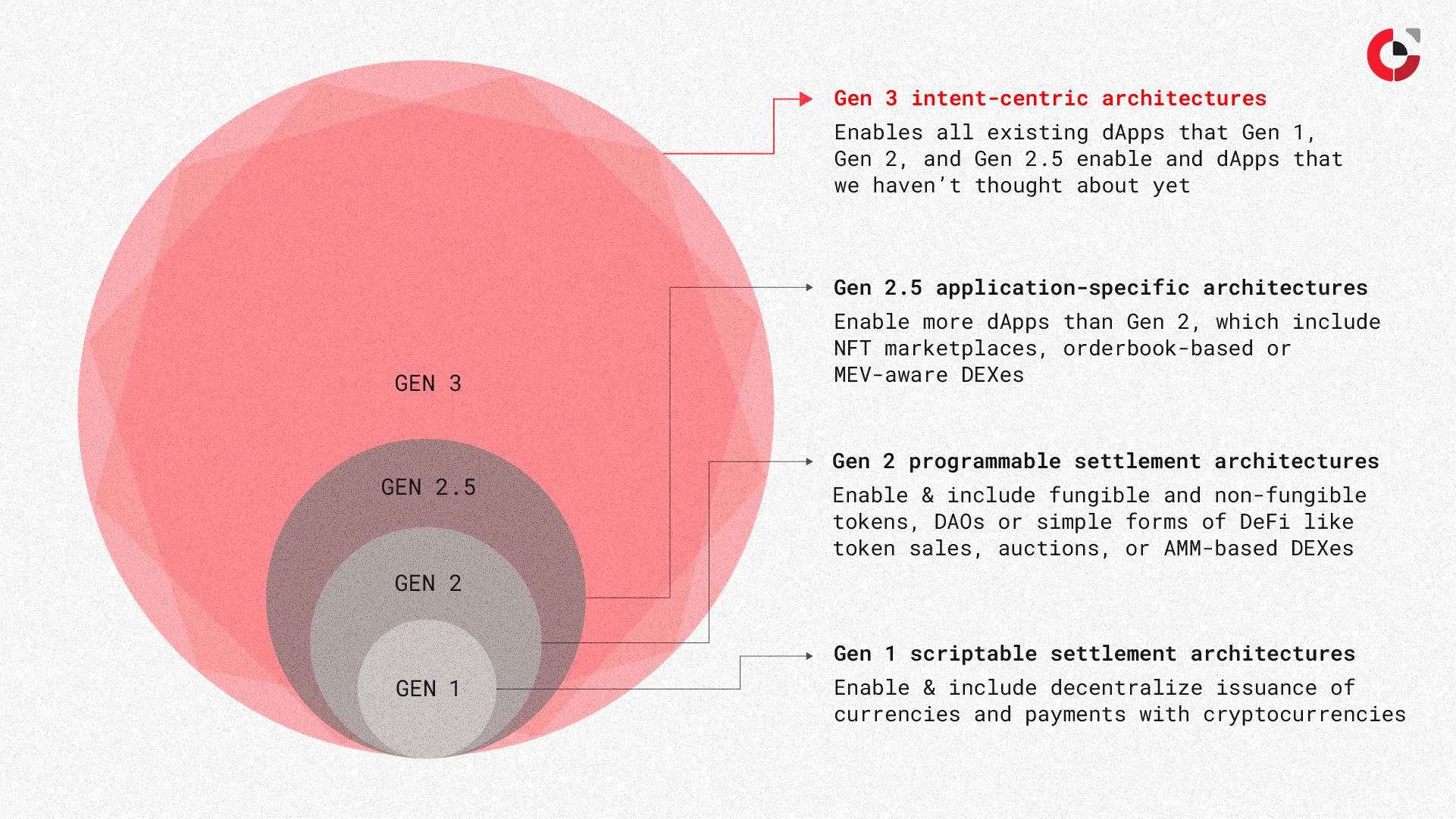- Eli5DeFi
- Posts
- Overview of Intent-Based Architecture
Overview of Intent-Based Architecture
Fundamentals of Intents, Solvers, and The Intent-Based Protocols.

Quick Bites
The way Web3 currently handles transactions is complex, which results in a less than ideal user experience and reduced efficiency. Users are forced to initiate transaction without understand the intent, this leads to frustration and greatest barrier for mass adoption
Intents are a declarative paradigm that allows users to express a desired outcome without specifying how to achieve it. The approach was changed to focus on the outcome for the user.
A protocol designed with an intent-based architecture improves the user experience. It also reduces blockchain congestion, optimizes resources, and is cost-effective for the network.
The advent of Intent-Based solutions brings innovation but also risks. These include centralization, rent-seeking behavior, monopolies, and scalability issues in multi-chain environments.
Read This First!
Before we continue, we suggest that you read references below first. It will give you the details from original sources of this article.
If you enjoy our articles and would like to receive them in your inbox, you can subscribe to our newsletter by clicking the button below.

Intent Exists Within Us
What are Intents?
Intents are a way for users to express what they want to achieve without specifying how to do it. When people desire something, they naturally form an intention.
In decentralized applications, intents remove the need to focus on the specific processes and methods to achieve a goal.
An intent-based architecture (IBA) revolves around intentions as the core element, and these intentions are not specific to a particular application but are more generalized.
In IBA, users define one or multiple desired end states, and the architecture is built to fulfill those intentions while adhering to the constraints set by the user.

What Are Intents?
The Solvers
One of the main parts of IBA is The Solvers/ Executors. The main role of solvers is to act as the counterpart to Intents. Their task is to identify and categorize users' intentions, and then provide the solutions they create.
Users can select the best solution offered by the solvers and still retain some control while delegating the complex process to them.
In this situation, there is a pseudo-layer called the "Intent-Layer" where problem solvers compete to offer the best and preferred solutions for users.
Innovative solutions driven by intent stem from the efforts of determined solvers who strive for improved results overtime, rather than simply engaging in transactions providing basic solution.

Intent-Specific Application
Example of Intent Solutions
Limit Orders
In IBA, limit orders involve expressing the intention to buy or sell an asset at a particular price, without specifying how to handle the order book or locate a match. The user wants to trade their assets with precise conditions, ensuring they avoid unfavorable deals.
Delegation
Users can grant specific permissions to others, allowing them to perform certain actions with their assets while retaining control. This allows for interaction with accounts in authorized ways, ensuring that the final transaction follows the defined rules.Gas Sponsorship
The goal is to carry out transactions without needing the native gas token. Users don't have to pay any gas fees themselves, as they can either get sponsored or pay the fees using a stablecoin like USDC instead of the native blockchain currency, ETH. Another person takes care of paying the ETH fees to achieve this goal.
Transaction Batching
Users want to perform various operations in a way that consumes less gas. They combine multiple intents or actions into one transaction to enhance efficiency and save costs.
Aggregators
Users want to be sure they're getting the best deal without having to check every option themselves. They take action based on the "best" price or yield, and they need proof that they've considered multiple options to find the most effective path.
Auction
The purpose is to trade under specific conditions and ensure the trade occurs in the most beneficial manner. It's like limit orders, but it uses a third-party mechanism to match multiple orders, aiming for the highest quality of execution.
There are still many unexplored possibilities for innovative solutions, but the underlying philosophy remains unchanged. Each application solution can be represented through intents.
Risks to Consider
While the advent of Intent-Based solutions has opened up new avenues for innovation, it is important to consider the accompanying risks. Some of these risks include:
Risk of Centralization
The move towards alternative mempools, such as intent-based systems, risks centralization if not managed carefully. A central entity controlling significant order flow could lead to rent-seeking behavior, where they charge users excessively for services, and censorship, where they control which transactions are processed.
Entrenchment of Rent-Seeking and Monopolist
The concern with intent-based systems is that they might give certain block builders exclusive access to transactions and intents, potentially leading to a monopoly in block production and a breakdown of the competitive market that is vital for the network's health.
Scalability Issues for Multi-Chain Purpose
Multi-chain environments add a layer of complexity to the intent-based architectures. The systems must be interoperable and able to handle the varying consensus mechanisms, fragmented liquidity, validation-execution delays, token standards, and smart contract languages. This complexity can limit the number of operators capable of managing such systems effectively.
Example of Intent-Based Protocols

Intent-Based Protocols

Conclusion
Web3 currently has complex transaction handling, leading to a poor user experience and reduced efficiency. Intents offer a declarative approach where users express desired outcomes without specifying the process, improving the user experience.
Intent-based architectures also reduce congestion, optimize resources, and are cost-effective. However, this innovation comes with risks such as centralization, rent-seeking behavior, monopolies, and scalability problems in multi-chain environments.
That’s a Wrap and Thank You!
I hope you enjoyed the articles!
I'm working on improving this newsletter and would love to hear your thoughts on what you'd like to see more of.
Thank you for reading!
of Intent



Reply